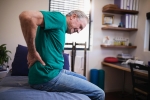There were more than 300 million cases of hip and knee osteoarthritis reported worldwide in 2017, with figures expected to rise even further in the future, particularly among women, according to data published in the Annals of the Rheumatic Diseases.
“In recent years, the burden of OA has been presented in several review papers based on few national studies, and no detailed information was provided across all countries,” Saeid Safiri, PhD, of Tabriz University of Medical Sciences, in Iran, and colleagues wrote.
“Moreover, worldwide OA burden was reported using the Global Burden of Disease (GBD) 2010 Study, but country-level information was not reported, and these overall OA burden estimates need to be updated from the 2010 estimates,” they added. “One study reported the global burden of musculoskeletal diseases using the WHO Burden of Diseases Database during 2000–2015, but it did not specifically focus on OA.”
To assess levels and trends regarding the incidence, prevalence and years-lived data for OA across the world, Safiri and colleagues studied publicly available modelled data from the 2017 Global Burden of Diseases, Injuries, and Risk Factors (GBD) Study. According to the researchers, the study included data from 195 countries and territories from 1990 to 2017.
There were more than 300 million cases of hip and knee osteoarthritis reported worldwide in 2017, with figures expected to rise even further in the future, particularly among women, according to data.
Safiri and colleagues used a systematic analysis of prevalence and incidence modelled data using the methods reported in the GBD study. The researchers presented all estimates as counts and age-standardized rates per 100,000 residents, with uncertainty intervals (UI).
According to the researchers, there were 303.1 million cases of hip and knee OA worldwide as of 2017, included nearly 15 million new cases reported that year.
The global age-standardized point prevalence of OA in 2017 was 3,754.2 (95% UI, 3389.4-4187.6) per 100,000, with an annual incidence rate of 181.2 (95% UI, 162.6-202.4) per 100,000. Researcher wrote this represents an increase of 9.3% (95% UI, 8% to 10.7%) and 8.2% (95% UI, 7.1% to 9.4%), respectively, from 1990. Additionally, the global age-standardized rate of years lived with disability in 2017 was 118.8 (95% UI, 59.5-236.2), representing an increase of 9.6% (95% UI, 8.3% to 11.1%) from 1990.
Global prevalence was higher among women and increased with age, peaking in men and women older than 95 years in 2017. The researchers also noted a positive association between the age-standardized rate of years lived with disability and SDI at the regional and national levels.
The age-standardized prevalence of OA in 2017 ranged from 2,090.3 to 6,128.1 cases per 100,000 residents. The three highest age-standardized prevalence rates were found in the United States (6,128.1; 95% UI, 5,729.3-6,582.9), American Samoa (5,281; 95% UI, 4,688-5965.9) and Kuwait (5,234.6; 95% UI, 4,643.2-5,953.6). Meanwhile, Oman (29.6%; 95% UI, 24.8% to 34.9%), Equatorial Guinea (28.6%; 95% UI, 24.4% to 33.7%) and the United States (23.2%; 95% UI, 16.4% to 30.5%) demonstrated the highest increase in age-standardized prevalence from 1990 to 2017.
“OA is a major public health challenge,” Safiri and colleagues wrote. “Although there is variation between countries in prevalence, incidence and [years lived with disability] due to OA, its burden is increasing in most countries, especially among women.”
“This trend is expected to continue as the ageing of the global population is rising,” they added. “Attempts to mitigate the future burden of OA require better awareness, especially of the risk factors, and early diagnosis and treatment of OA together with the improvement of health care infrastructure for managing the increasing number of patients with OA. Continuing to expand OA population-based data collection at the national level is essential to monitor the disease burden and to further deal with the need for better care.”
Source; Healio


 Book an Appointment
Book an Appointment




